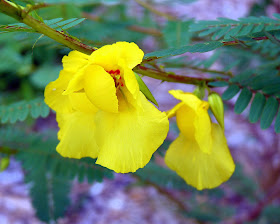Partridge Pea (Chamaecrista fasciculata) is a native wildflower in Florida and throughout much of the U.S. east of the Rockies. It's an annual, lasting until the first heavy frost, but reseeds easily. Once you have it established in an area, you can expect to see it pop up each summer without any encouragement. It grows quickly from the ground; the plant shown above took about a 4-6 weeks to reach its current height of about 3 feet. The leaves are feathery and sensitive to the touch; the leaflets will fold up during rain and each evening at dusk. The bright yellow flowers appear along the stem at intervals where the leaves meet the stem (known as the "leaf axil"), and will be followed by seed pods that resemble pea pods.
 Partridge Pea serves as a host plant for several butterflies, including the Sleepy Orange and some sulphurs. My Florida Backyard has been invaded regularly by Sleepy Oranges lately, and the Partridge Peas are full of eggs, which resemble little grains of rice. Because Partridge Pea has nectar glands along the stem, the plant is very attractive to ants. These ants will frequently carry off the caterpillar eggs and even young caterpillars, so it's a good thing that the butterflies lay their eggs in volume. A recent survey of one Partridge Pea plant yielded over 30 eggs before the surveyor (yours truly) stopped counting due to the sweat blurring her vision.
Partridge Pea serves as a host plant for several butterflies, including the Sleepy Orange and some sulphurs. My Florida Backyard has been invaded regularly by Sleepy Oranges lately, and the Partridge Peas are full of eggs, which resemble little grains of rice. Because Partridge Pea has nectar glands along the stem, the plant is very attractive to ants. These ants will frequently carry off the caterpillar eggs and even young caterpillars, so it's a good thing that the butterflies lay their eggs in volume. A recent survey of one Partridge Pea plant yielded over 30 eggs before the surveyor (yours truly) stopped counting due to the sweat blurring her vision.We love any plant that brings butterflies to My Florida Backyard, and Partridge Pea is an easy-to-grow native that fits in any wildflower garden. Obtaining seeds or starter plants can be a little difficult; try a native nursery or wildflower website, or watch for plants along the side of the road and gather some seeds for yourself (not on private property, of course!). If you can get your hands on it, Partridge Pea is definitely worth the space in your wildlife-friendly garden!



I'll have to find some! The feathery compound leaves look great on trees and shrubs... they remind me of miniatures of many of the south Florida flowering trees.
ReplyDelete